On the origin of life
A week ago someone asked me about the origin of life. I gave them some basic pointers but since it's not my area of expertise I went on to read a bit on the latest developments in the field. I then thought I could share with my fellow steemians what is hopefully an introduction to the subject that anyone can understand.

Abiogenesis
The origin of life [1] is studied by the field of "abiogenesis," which roughly means "creation (of life) from non-life." While we don't really know how life first appeared or what it looked like, there are some things we can be somewhat certain of and others we can have fun speculating on. It is widely understood that the Earth formed around 4,600 million years ago, and life itself may have appeared as early as 4,300 million years ago. We may not know the specifics, but we can largely rest assured it all started thanks to basic physical and chemical processes found on primordial Earth:
The constituent atoms of whatever shape that first lifeform took were there when our solar system accreted, many small molecules, including water, came together during this accretion process
Highly energetic sources such as lightning strikes, geothermal vents, impact events and/or admittedly less energetic UV radiation served to foment the formation of bonds between atoms and other small molecules, creating relatively complex organic molecules
As we understand it, there were vast quantities of liquid water in the primordial Earth. Water is a very good solvent, which allows for molecules to interact with each other (and thus for chemistry to occur).
The key component of organic chemistry is carbon (C), a pretty versatile element. Each carbon atom can make up to four bonds, not only with other carbon atoms but with plenty of other elements too, including hydrogen (H), oxygen (O) or nitrogen (N). Altogether, these are four of the most abundant elements in the universe, which could suggest carbon-based life to be relatively common.
A famous experiment that first attempted to test how simple inorganic molecules may interact with each other when in the presence of water and struck by energy sources was the so-called Miller-Urey experiment, conducted in 1952 by Stanley Miller and Harold Urey.
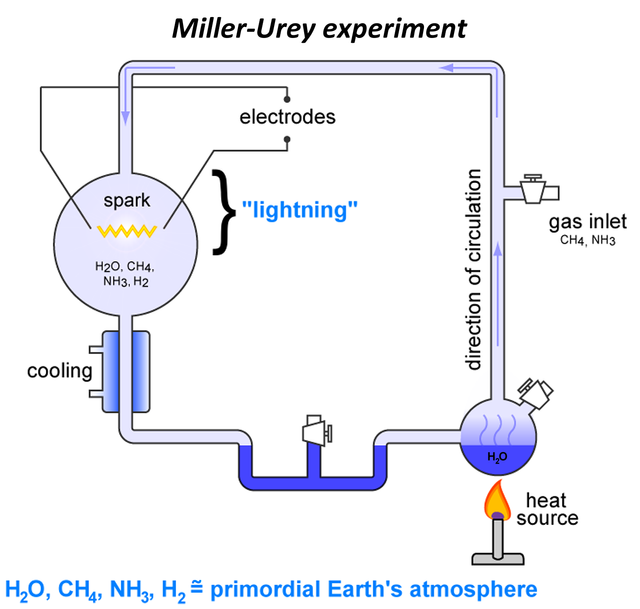
As seen in the diagram above, the experiment attempted to simulate the conditions found on primordial Earth to assess whether those could lead to the generation of biological molecules from mostly inorganic matter, i.e. from water (H2O), methane (CH4), ammonia (NH3) and hydrogen (H2). After running the experiment for a single week, the scientists found that multiple amino acids (see Table 1 below) had been created.
Similar experiments have been conducted multiple times since then. Perhaps the most interesting ones occurred around the turn of the millennium because by then we had learned that the early Earth atmosphere was probably more complex than initially thought (volcanic eruptions may have been releasing hydrogen sulphide, carbon dioxide, carbon monoxide and phosphates into the atmosphere). These more recent experiments have produced an even wider range of molecules, including the building blocks for nucleotides.
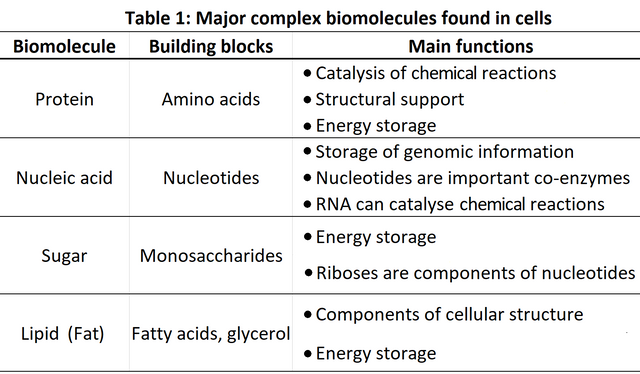
There's still ongoing debate regarding Earth's initial atmosphere and these experiments only really cover each a slice of all that was probably happening at the same time back then, but hopefully I have convinced you that the relatively complex biological molecules essential for life today could have been created from small and mostly inorganic compounds back in Earth's nursery days.
Before moving on you should be aware I have decided not to dwell on molecular genetics to keep things flowing. The origins of life were very molecular so you will still want to check the following image to get a grip on some basic properties of DNA and RNA. If you are feeling extra curious—a feeling you should only fear if you are a cat—you can always read this article which I think does a decent job of explaining all the basics.

Metabolism or genetics?
So we have reason to believe the early Earth would've been riddled with complex organic molecules arising from natural physical and chemical processes, what's next? Well, there are two schools of thought: "metabolism first" where metabolic pathways may have appeared before genetic material or "genetics first" where obviously genetic material appeared first (of course, it could be that both basically co-appeared and co-evolved).
This is important because nowadays genomes cannot exist without metabolism (they need metabolism to replicate, repair, everything really). You can think of the genome as the blueprint to a building, unless it has engineers, workers and etc. (i.e. "metabolism") to read it accurately and bring the raw materials to shape, the blueprint will just be an inert and basically useless piece of paper. Conversely, metabolism needs genomes to exist (genomes code for, among other things, the enzymes and other molecules that create metabolism: it's not a blueprint for the building only, but also for the workers and engineers!). We are left with your typical chicken-or-egg kind of question [2].
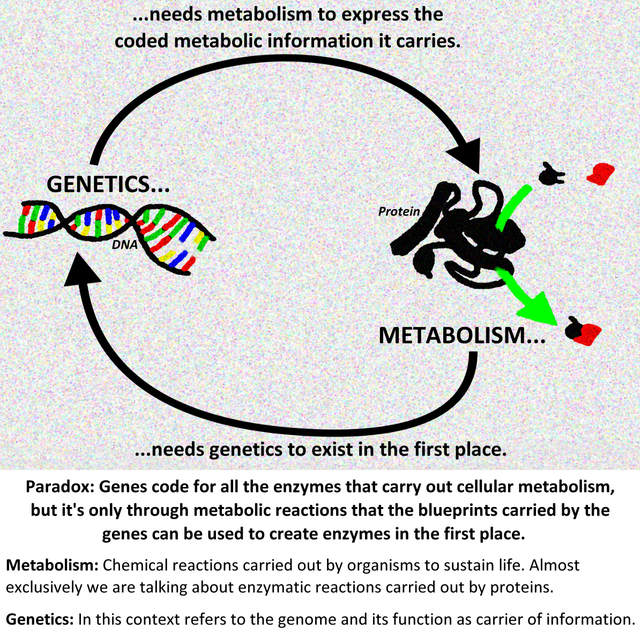
A world of RNA
The easiest way to solve this genetics-metabolism paradox is to assume that that original molecule that stood at the threshold between life and non-life was able to do both, even if it perhaps started as only genetics or only metabolism. One such scenario is known as the "RNA world" hypothesis. This concept took proper shape in the 1980s following the discovery that RNA could catalyse chemical reactions, something that was thought to be reserved only for proteins [3] and which earned Sidney Altman and Thomas Cech the 1989 Nobel Prize in Chemistry. The idea was that the hypothetical initial RNA molecule that set life in motion was able to catalyse its own replication. Since then, self-replicating RNAs have been actually created in the lab so we know it's at least possible.
Once the first replicator arises, natural selection [4] can take place and the story of life can begin. I won't bore you with a wall-of-text-explainer when you can instead look at this beautiful figure I made:
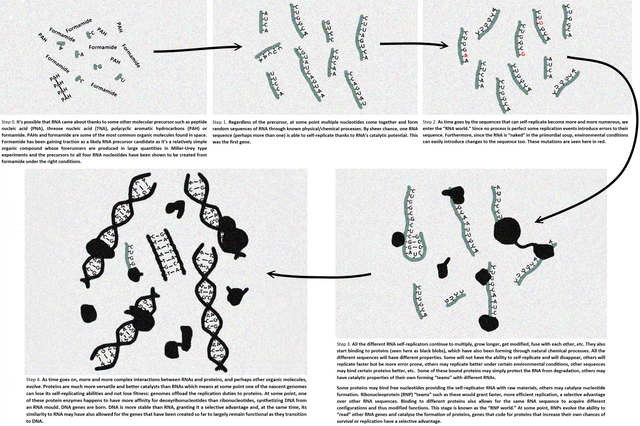
The cell rises
So we have evolved rather complex molecular genetics-metabolism systems that can replicate, but is this life? Well, one of the key features we are still missing that currently defines life on Earth is the cell. The gene may be the basic unit of selection, but the cell is the basic unit of life. If you are a piece of genetics-metabolism floating in the ocean, you may be able to evolve via natural selection, but you can't control the conditions of the ocean! Now, the contents of a cell? Yeah, you could do that. This is something we call homeostasis, the ability to maintain your internal environment within certain limits, a key feature of living beings.
To understand how the first cell came into being we must turn to lipids. Yes, greasy, nasty fats actually have very interesting properties other than making your cheese-burger tasty. Phospholipids in particular readily self-assemble into liposomes or micelles (see picture below) when in aqueous solution and, interestingly enough, the cell membrane shares the same basic structure with liposomes. This happens because these molecules are very polarized: one end is hydrophilic (attracts water, repels lipids), the rest is hydrophobic (repels water, attracts lipids). For an idea of how we can go from liposomes to cells take a look at the gorgeous figure below:
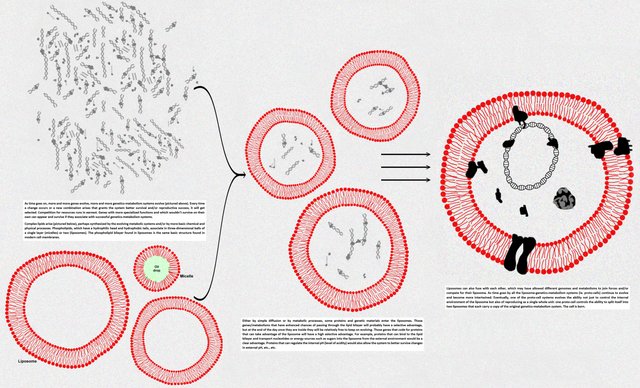
A world of other possibilities
Many of the steps exemplified here would have happened by sheer chance, and we could be talking about exceptionally low chances... but things with low probabilities can become inevitable over a long enough period of time and that's something we have in spades with a solar system 4,600 million years old. The process may have had many false starts, but once it got going in earnest it would’ve been difficult to stop thanks to natural selection.
Now, it could have been that metabolism arrived first, with proteins catalysing random reactions all over the place until some genetic material came along and co-opted those proteins whose reactions granted it better fitness. Maybe DNA didn't take over until well after RNA genomes had colonized liposomes. I brought to you a story with neat steps to make it easy to follow, but the reality was probably veeeery messy, with multiple things happening all at once. Our current knowledge tells us that the RNA world scenario like I pictured above had a decent degree of likelihood, but we don't know for sure and probably never will.
Panspermia?
But what if abiogenesis didn't originally occur on Earth, either partially or completely? This is where panspermia, which roughly means "seed all around," comes in. We know that many terrestrial microorganisms are extremophiles, meaning they can survive and thrive in conditions we would consider, well, extreme. Deinococcus radiodurans is a species of bacteria first discovered as it survived gamma-ray sterilization of foodstuffs. On top of that, it has since been shown to also survive extreme conditions of cold, acid, dehydration and vacuum. Many more unicellular species make their living in hydrothermal vents for example, in temperatures that can reach the boiling point of water.
Why should we care about all this? Well, it shows life could survive the trip on space aboard an asteroid and also the crash landing on a new planet. For example, extremophiles have survived the disintegration of the space shuttle Columbia and a later experiment showed that naked DNA can survive the harsh conditions of atmospheric re-entry intact enough to be functional again once introduced into bacteria.
This doesn’t necessarily mean that life originated outside of Earth. Perhaps there was a nascent metabolism on Earth and it joined forces with a newly fledged genetics that arrived on a meteor. Or maybe life did originate on Earth and it has been seeding other places of our solar system and beyond. This promiscuous exchange of life/genetics/metabolism within a planetary system could easily happen. When impact events of enough magnitude occur, the explosion can eject rocks from the planetary surface out into space, rocks potentially carrying microscopic colonizers awaiting to crash land on another celestial body.
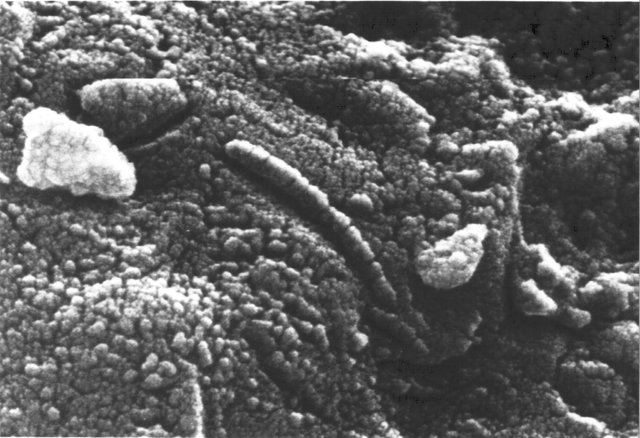
So that's it, folks, some of the modern mainstream ideas and understanding on how life could have started. Was this enjoyable to read? Did you learn something? Was it a bore? TLDR? Let me now!
Notes
[1] Believe it or not, defining "life" can be difficult. For the purpose of this article we are talking basically about systems that carry a) genetic information and b) metabolic reactions that allow for the perpetuation of the genetics-metabolism system. In modern Earth such systems are found exclusively in the form of cells, such organisms can be either unicellular or multicellular.
[2] Gotcha covered. Amniote eggs evolved around 300 million years ago, way before anything resembling a chicken ever walked the Earth.
[3] To be fair, the RNA world hypothesis is built on other bits of evidence too. Some basic RNP machinery (namely ribosomes) found in every cell of every species could be a left-over from the "RNP world" era and many basic molecules utilized virtually universally by cells are also closely related to RNA (molecules such as FADH or NADH).
[4] Natural selection is just the name we give to something that happens when any group of replicators, whether naked pieces of RNA or humans, passes copies/offspring to the next generation. Natural selection acts on populations (not individuals) and necessitates the presence of differences between those individuals. For example, if half the individuals that make up a given population of replicators have a striking fur colour that makes them easy to spot for a new predator that has been introduced, those individuals will have higher chances of dying before passing on offspring. In other words, they will have a selective disadvantage or reduced “fitness” in that particular moment and place. As a consequence of this, individuals with the striking fur colour will pass on a relatively lower amount of offspring into the next generation: natural selection will "select" for those members of the species that have a more muted fur colour that blends in with their environment. As generations go by, the population can go from being a proportion of 50:50 in terms of their colouration, to being perhaps 90:10 in favour of the muted fur color. That is evolution (any change in the genetic frequencies of a population). While not the only one known, natural selection is currently understood to be the most important mechanism for evolution.
Sources and further reading
"Life's working definition: Does it work?" at NASA.gov
"Mystery of Earth's water origin solved" at National Geographic
"Evidence for early life in Earth’s oldest hydrothermal vent precipitates" at Nature
"A production of amino acids under possible primitive Earth conditions" at Science - Original Miller-Urey experiment.
"Formation of nucleobases in a Miller-Urey reducing atmosphere" at PNAS
"Experimentally tracing the key steps in the origin of life: The aromatic world" at Astrobiology
"Genetics first or metabolism first? The formamide clue" at Chemical Society Reviews
"Highly efficient self-replicating RNA enzymes" at Cell Chemical Biology
"Self-sustained replication of an RNA enzyme" at Science
"Molecular genetics made simple" at Global Cardiology Science & Practice
"DNA can survive reentry from space" at Scientific American
You just planted 0.12 tree(s)!
Thanks to @tychoxi
We have planted already 3459.41 trees
out of 1,000,000
Let's save and restore Abongphen Highland Forest
in Cameroonian village Kedjom-Keku!
Plant trees with @treeplanter and get paid for it!
My Steem Power = 39463.73
Thanks a lot!
@martin.mikes coordinator of @kedjom-keku
I strive not to be a man of success, but rather to be a man of value.
Definitely not boring, to answer your last question. I am surprized no one commented your post yet (maybe slightly too long for most readers? I don't know... not for me at least). You discussed a complex topic in a manner easy to follow, a least for me who is not from that field at all. Thanks for sharing all of this.
I unfortunately don't have interesting questions, as everything was kind of pretty clear. Sorry for that.
Well, thank you! Good to know someone enjoyed it and learned something new.
This post has been voted on by the steemstem curation team and voting trail.
There is more to SteemSTEM than just writing posts, check here for some more tips on being a community member. You can also join our discord here to get to know the rest of the community!
Thanks for the legwork. Now I ain't gotta do it. =)
You're welcome haha!
i like
Waoo, seems much like the theory of everything.
Really this was an interesting read. As complex it can be, science will always have its own say.
I still wish to stick to my believe about the origin of life. No one really can boldly say without doubts the true origin of life. As humans we do our research to find out.
I must say you succinctly explained a whole lot of concept here. Thumbs up
Yeah, we certainly don't have enough evidence today to have a solid theory of abiogenesis and you are also free to believe what you may. But hopefully you learned something about what evidence there is so far!
Hi @tychoxi!
Your post was upvoted by utopian.io in cooperation with steemstem - supporting knowledge, innovation and technological advancement on the Steem Blockchain.
Contribute to Open Source with utopian.io
Learn how to contribute on our website and join the new open source economy.
Want to chat? Join the Utopian Community on Discord https://discord.gg/h52nFrV
This is biology @ its simplest form. Thanks for the lengthy, but needful education @tychoxi!
Evolution of man? this somehow looks like the big band theory I studied in my first year in the university.
I have read some evolution theory and at the end it seemed unclear and questionable. There is always a loophole.
The Big Bang is the theory of how our universe came to be and its early stages, this is very different, it's the origins of life here on Earth. I'm sorry if you didn't have good courses on evolution, writing evolution explainers is something I have planned for the future.
I am looking forward to read them! :)
:D
The word early is key here. Based on how soon life appeared, and also based on how much longer it took for prokaryotes to become eukaryotes (~a billion years), it seems to be the case that life is pretty easy to bring about. The step from non-life to life seems to be much easier than the step from simple life to more complicated life.
Enjoyable and very clear post!
Yeah, even later origins (which usually are suggested to be around 3900 million years ago) are still pretty early which could totally suggest that life is almost an inevitability if the starting conditions are right. This is one of the reasons I'm pretty confident our very own solar system has plenty of unicellular life outside of Earth. And if panspermia has been indeed going on, then those lifeforms may end up being rather boring due to their similarities to terrestrial life! If multicellularity has also evolved, those creatures could be much more interesting.
Quite true.